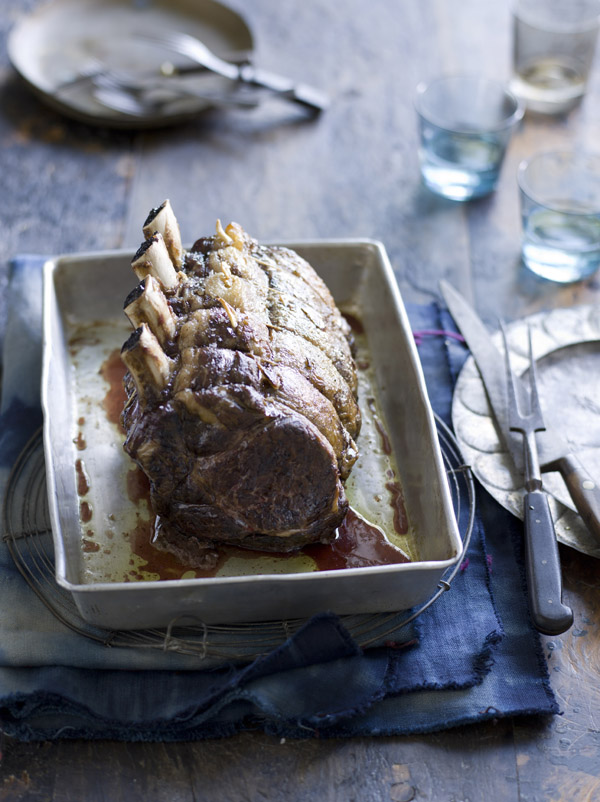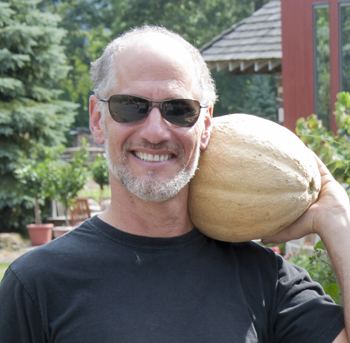Although pretty much any beef rib roast is referred to informally as prime rib, less than 1 percent of the beef that is produced in the United States is actually officially graded "Prime," and most of that never reaches the retail market. In fact, the "prime" rib you purchase is usually "Choice" grade, which is fine; but if you know a butcher who deals in true Prime meat, this recipe might be an occasion where you want the real thing. The combination of opulent marbling from Prime-level husbandry and lithe tenderness that is the hallmark of slow-roasted meats is hard to top.
Because a whole primal cut of beef rib is huge, weighing more than 40 pounds/18 kilograms, a butcher is likely to ask you from which section you'd like your roast cut. End-cut rib roasts are more flavorful, fattier and have an eye (the uninterrupted section of meat in the center of the roast) that is smaller and more striated with fat. Center-cut rib roast has a larger, leaner eyesection, a milder flavor, and less fat. Choose whichever one suits your purposes best. Nothing beats the flavor of an end-cut rib, but if you want perfect lean slices that will wow your most discriminating guests, go for the center cut.

Chilling time: 12 to 24 hours
Prep time: 10 minutes
Cooking time: 4 1/2 to 6 1/2 hours
Store: Up to 2 days, covered in the refrigerator. Reheat gently in a low oven.
Slip the garlic slivers between the meat and fat on the top of the roast, and between the meat and bones on the bottom. Season the roast all over with the salt and pepper and refrigerate, uncovered, until the surface is visibly dry, at least 12 hours and up to 24 hours. Remove from the refrigerator 1 hour before you plan to start roasting.
Preheat the oven to 550°F/290°C.
Place the beef in a large roasting pan, fat-side up, and roast for about 20 minutes, or until the surface is starting to brown. Reduce the oven temperature to 150°F/65°C. (If your thermostat doesn't go that low, set it at its lowest setting, often 175°F/80°C.) Roast until an instant-read thermometer inserted into the center of the meat (but not touching bone) registers 135°F/57°C, 4 to 6 hours.
Transfer the meat to a carving board, tent loosely with aluminum foil, and let rest for 15 minutes.
Stand the rested roast upright, and use a sharp carving knife to cut between the bones and the meat. Detatch the bones. Hold the roast steady with a carving fork or your hand, and slice the meat into thin, even slices.
Divide the slices among dinner plates and serve immediately.
Note: Beef rib roasts are sold by the number of ribs in the roast, with each rib weighing about 2 pounds, and feeding 2 people (a pound of bone-in rib yields less than 1 pound of edible meat).
Variation: Rib Roast with Garlic Jus
After transferring the finished roast to a carving board, pour the pan drippings into a gravy separator. Spoon 2 tablespoons of the fat from the surface into a saucepan and heat over medium-high heat. Add 2 garlic cloves, minced, to the fat and cook until aromatic, about 30 seconds. Add the meat juices from the separator, leaving the remaining fat behind. Add 1 cup/240 ml dry red wine and bring to a boil. Add 1 cup/240 ml good-quality low-sodium beef broth, return to a boil, and cook until reduced by half, about 10 minutes. Season with salt and pepper. Stir in 1 tablespoon chopped fresh flat-leaf parsley. Carve the beef and serve with the jus.
Variation: Rib Roast with Port Wine Glaze
After transferring the finished roast to a carving board, spoon the fat out of the pan and discard, or pour all of the pan drippings into a gravy separator and pour the meat juices back into the roasting pan, leaving the fat behind. Add a sprig of fresh rosemary and 2 cups/480 ml port wine to the pan. Place over medium-high heat (make sure you have a flameproof roasting pan) and boil until reduced by half, about 10 minutes. Discard the rosemary. Carve the beef and serve with the sauce.
BONELESS VERSUS BONE-IN MEATS
 Bones slow down the movement of heat through meat, which is why boneless chicken and turkey roast so much more quickly than bone-in birds. It's also why they dry out. Whenever you roast delicately textured meats, like poultry breast, pork, lamb, veal or fish, slowing down heat transference, either by lowering the oven temperature or choosing cuts on the bone for roasting, reduces the chance that the meat fibers will get hot enough to break down and dry out. Slow cooking bone-in meats and fish doubles the delicious benefits.
Bones slow down the movement of heat through meat, which is why boneless chicken and turkey roast so much more quickly than bone-in birds. It's also why they dry out. Whenever you roast delicately textured meats, like poultry breast, pork, lamb, veal or fish, slowing down heat transference, either by lowering the oven temperature or choosing cuts on the bone for roasting, reduces the chance that the meat fibers will get hot enough to break down and dry out. Slow cooking bone-in meats and fish doubles the delicious benefits.
###
About the Author
Andrew Schloss is a cooking teacher, food writer, food industry consultant and cookbook author. He is the former president of The International Association of Culinary Professionals and former director of the culinary curriculum for The Restaurant School in Philadelphia. He lives with his family in eastern Pennsylvania. Cooking Slow is his latest cookbook.
Author: Andrew Schloss
Other Works: The Art of the Slow Cooker, Fire It Up and Mastering the Grill
Publisher: Chronicle Books
What's Inside: 94 recipes that deliver big flavor with little hands-on-time in the kitchen. In addition to the crock-pot ideas you'd expect, this cool collection includes chapters on roasting, baking, simmering, steaming, grilling, frying and making sweets, all using low temperatures. You'll find everything from Slow-Simmered Bourbon Bacon Beans, which can cook on a back burner while you tackle other chores, to Overnight Lemon Cheesecake, which bakes in the oven while you sleep!
Geared for cooks of every skill level, this invitation to relax shows how cooking at lower temps for longer time periods can simplify your life. Each recipe includes the time required for prep and cooking as well as suggestions on how to store your creation. And many offer optional shortcuts and variations that allow use of a slow cooker if desired.
Time Out: 224 pages
Available: $35 at Amazon and other retailers
You'll also enjoy:
